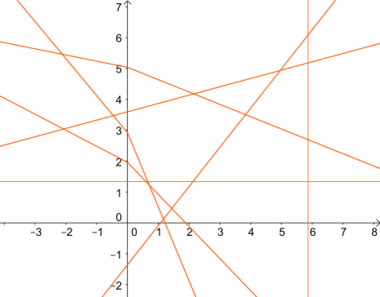Moulton plane
In incidence geometry, the Moulton plane is an example of an affine plane in which Desargues's theorem does not hold. It is named after the American astronomer Forest Ray Moulton. The points of the Moulton plane are simply the points in the real plane R2 and the lines are the regular lines as well with the exception that for lines with a negative slope, the slope doubles when they pass the y-axis.
Formal definition
The Moulton plane is an incidence structure [math]\displaystyle{ \mathfrak M=\langle P, G,\textrm I\rangle }[/math], where [math]\displaystyle{ P }[/math] denotes the set of points, [math]\displaystyle{ G }[/math] the set of lines and [math]\displaystyle{ \textrm I }[/math] the incidence relation "lies on":
- [math]\displaystyle{ P:=\mathbb R^2 \, }[/math]
- [math]\displaystyle{ G:=(\mathbb R \cup \{\infty\}) \times \mathbb R, }[/math]
[math]\displaystyle{ \infty }[/math] is just a formal symbol for an element [math]\displaystyle{ \not\in\mathbb R }[/math]. It is used to describe vertical lines, which you may think of as lines with an infinitely large slope.
The incidence relation is defined as follows:
For [math]\displaystyle{ p = (x, y) \in P }[/math] and [math]\displaystyle{ g = (m, b) \in G }[/math] we have
- [math]\displaystyle{ p\,\textrm I\,g\iff\begin{cases} x=b&\text{if }m=\infty\\ y=\frac{1}{2}mx+b&\text{if }m\leq 0, x\leq 0\\ y=mx+b&\text{if }m\geq 0 \text{ or } x\geq 0. \end{cases} }[/math]
Application
The Moulton plane is an affine plane in which Desargues' theorem does not hold.[1] The associated projective plane is consequently non-desarguesian as well. This means that there are projective planes not isomorphic to [math]\displaystyle{ PG(2,F) }[/math] for any (skew) field F. Here [math]\displaystyle{ PG(2,F) }[/math] is the projective plane [math]\displaystyle{ P(F^3) }[/math] determined by a 3-dimensional vector space over the (skew) field F.
Notes
References
- Beutelspacher, Albrecht; Rosenbaum, Ute (1998), Projective Geometry : From Foundations to Applications, Cambridge University Press, pp. 76–78, ISBN 978-0-521-48364-3
- Moulton, Forest Ray (1902), "A Simple Non-Desarguesian Plane Geometry", Transactions of the American Mathematical Society (Providence, R.I.: American Mathematical Society) 3 (2): 192–195, doi:10.2307/1986419, ISSN 0002-9947
- Richard S. Millman, George D. Parker: Geometry: A Metric Approach with Models. Springer 1991, ISBN 9780387974125, pp. 97-104
 |


